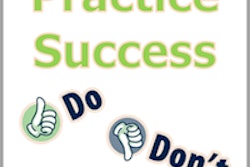
Having every day's time slots filled with patient appointments is one sign you've made it as a dentist, but a jam-packed schedule could be driving your staff crazy -- and making your practice less profitable.
"If a doctor isn't scheduled properly, the day will gradually become more inefficient," says Amy Kirsch, a dental management consultant in Centennial, Colorado."The daily stress your staff experiences is directly related to how your day is scheduled."
Kirsch tackled this topic in her presentation,"Scheduling for Success" last week at the American Dental Association's 148th annual session in San Francisco. Kirsch works with dentists and their staffs to better manage patient bookings in order to ease stress loads and increase profits.
"It's typical for a schedule to look great first thing Monday morning, but when the cancellation calls start coming in, it starts to fall apart."
Kirsch identified four different organization levels she sees in dental practices:
- Level 1: Chaos. Office systems are totally disorganized or non-existent, and the doctor is so overbooked and in so many places at once that longer appointments for crowns and cavities fall through the cracks. "At this level, the patients are controlling the schedule," says Kirsch.
- Level 2: Managed. The doctor is efficiently managing the staff, who are efficiently managing the systems, and the emphasis is on quality of care and relationships. "Fewer patients scheduled means less stress for the staff and more time for the doctor to build a rapport with staff and patients--to talk about kids, vacations, hobbies, and so on."
- Level 3: Organizational. Staff has a daily plan of what dollar amounts it will produce that day, and schedules appointments using software that color-codes by procedure and organizes procedures by time slots. "Everyone is on the same page for scheduling."
- Level 4: Leadership. The acme, with the doctor in on scheduling procedures and leading staff to manage schedules with zero defects.
"These levels can change daily, but think about which one you're usually at throughout the week," says Kirsch."At the very least, you should know the dollar amounts per day you plan to generate, or at least, how many procedures you'll do per day."
The morning huddle
One of the most effective ways to keep scheduling on track is to address it in a daily morning staff meeting. "This is the time to solve scheduling problems before they begin, and be proactive instead of reactive," Kirsch says.
Specific actions to take:
- Review the schedule for the day and identify any problem areas.
- Identify times that can be set aside for make-up appointments and patients with emergencies.
- Identify patients who have medical needs beforehand (who's sensitive to pain, what tooth is feeling sensitive, etc.)
- Make sure there's enough materials set aside for crowns, fillings, and the other procedures.
- Discuss the problem patients (who has Alzheimer's, who was recently widowed, who whines) and procedures in place to handle them.
- Discuss any changes from the daily routine so technicians know how to set up their rooms.
- Discuss the prior day's schedule -- what went right and what went wrong.
- Identify the next available timeslot for a major appointment."This is especially important for the dentist to know so he doesn't mistakenly tell a patient that she can get a crown next week when it's actually two months out," says Kirsch.
- Define the goal for the day and how to meet it, such as turning an emergency appointment into an initial exam.
- Finish with a motivational boost to end the meeting on a positive note.
Overlapping versus overbooking
"A typical appointment book is choc-a-bloc and too often overbooked," says Kirsch. "Some doctors view that as a good challenge, but it's not great when she is doing a 10-minute filling that overlaps with the last 20 minutes of a scheduled crown procedure."
Instead, she says, schedulers should mark up every appointment, breaking it down to the amount of time the dentist and/or the hygienist will spend with the patient in 10-minute increments. Kirsch recommends using symbols, like "/" to mark when the doctor and assistant will be working together on a patient, and "*" for when it's only the assistants. Say four patients are coming, with an hour in between and a dentist must meet with each. The scheduler should put the "/" in the beginning or middle of every appointment, so the dentist can move onto the next appointment while the assistant alone, "*", can start and finish up the procedure.
"The dental assistant can also move the dentist along by saying, 'Wouldn't this be a great time to see Mrs. Smith next door for her crown procedure?' Sometimes dentists need to be prodded because they are focused on the tooth at hand."
The ideal schedule
Kirsch says heavy production (crowns, root canals, new patients) should take place in the morning, followed by slots for emergencies set at lunchtime, and fillings and crown seats in the afternoon."The most difficult procedures should be done in the first five hours to get them out of the way. You'll be beat when lunchtime comes around, but the afternoon will seem like a piece of cake."
Schedulers should fill the difficult time slots (typically 10 a.m. to 2 p.m.) first. To do that, offer patients a limited choice of times."(I have a slot Tuesday at 10 a.m. or Thursday at 2 p.m. Which one would work better for you?)" Don't ask an open-ended question like "what day and time works best for you?" If the patient can't make either time offered, still try to book them in the morning to stay on track."(Because this is an intricate procedure, Dr. Jones would like to see you in the morning to allow more time.)"
Every schedule gets cancellations every day, leaving an opening for those on the priority call list. But schedulers should consider whether it's worth filling in every time slot."If the day is getting too hectic and staff needs a break, it's better to re-schedule for another day," Kirsch says.
What's a day without a missed appointment? Two days in advance is standard for reminder calls. Dental offices also need to remind patients about the cancellation fee, if they have one, but give a gentle hint instead of a blatant threat, says Kirsch."(As you know, we kindly request a 48-hour notice in case you change your appointment.)"
One way to get late-cancelling patients to change their minds is calling them up and playing the guilt card."(I'm so sorry you'll not be able to keep your appointment this afternoon. I know Dr. Jones was looking forward to seeing you. Because I will not be able to fill this appointment time, is there anything I can do to help you keep this appointment?)" "Instead of shaming them, beseeching will make them feel guilty for skipping out, and they'll reconsider and come in for their appointment,"says Kirsch.
If a patient cancels three times in a row or does two no-shows, it's time to boot them from the practice."[Such patients] could cost you several hundred dollars of your hygienist's salary," says Kirsch. Send the person a certified letter announcing he has two weeks to have any emergency needs taken care of, and request the address of their new dentist to send records to (check your state's requirements to see if this is legal)."Scheduling is hard enough without dealing with bad patients," Kirsch concludes."Focus on efficient scheduling your good clients -- it will make both them and your staff happy."



















